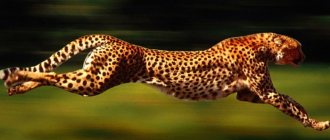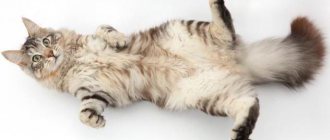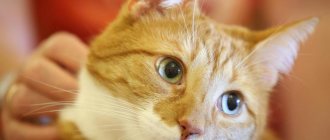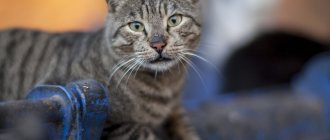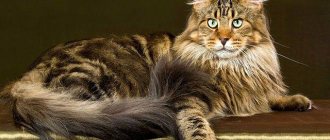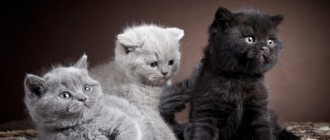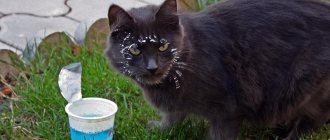The leopard is the most graceful and colorful member of the cat family. This extremely fast and dangerous predator belongs to the cat family and the panther genus. Leopards are notable for their spotted color, which allows them to camouflage well in their habitat. At the moment, most subspecies of leopards are listed in the Red Book as endangered species in need of protection.
Leopard subspecies
In total there are about 8 subspecies of leopards. Let's look at each of them in more detail:
Indochinese leopard
This representative is distinguished by its black color. The species numbers only 2,500 representatives. They live in southeast Asia. Until 2020, they inhabited Singapore, Cambodia and southern China. Due to widespread deforestation, poaching and trade, fur has become extremely rare.
Ceylon leopard
A fairly large subspecies of leopard with a body length of 142 centimeters and a weight of up to 77 kilograms. It lives on the island of Ceylon, which is commonly known as Sri Lanka. There are only 950 individuals in total.
North China leopard
It has a body length of up to 136 centimeters and a weight of about 75 kilograms. Inhabited the mountains and forests of the central and northeastern region of China. A very small species with populations of no more than 348 individuals.
Javan leopard
An endangered subspecies found in Indonesia on the island of Java. Mostly black in color, but sometimes spotted species are also found. The total population of this species is 525 representatives. Extinction occurs due to the reduction of their habitat.
South Arabian leopard
A small representative with a body length of up to 140 centimeters and a weight of 30 kilograms. Notable for its both pale and bright yellow body color. The rosettes on the fur have a patterned structure. For some time, the number of South Arabian leopards was widespread, but since 2008 there are no more than 200 species in the Arabian Peninsula.
Far Eastern leopard
It has several other names: Amur, Korean, Manchurian and East Siberian. The body size is 136 centimeters in length with a weight of no more than 75 kilograms. It differs from other representatives in its long and soft fur texture. During the cold season, the color changes to lighter than in the summer. The area of the lower torso and limbs are painted white. Distributed throughout China, North Korea and the Russian Federation. Literally a hundred years ago it inhabited the entire Korean Peninsula. In 2014 alone, there were 50 representatives of the species. Active measures are being taken to preserve and increase the size of the remaining population.
Persian leopard
This is a fairly large representative of the species with a body length of about 183 centimeters and a weight of up to 60 kilograms. It is distinguished by its dull grayish-orange fur color. The surface of the body is covered with sparse brown spots. Persian leopards have spread throughout Iran, Pakistan, Iran, Turkmenistan and Turkey. In total there are only 1290 representatives of the species. Previously, individuals spread throughout the North Caucasus, but completely disappeared in the mid-20th century.
African leopard
This is the most numerous subspecies. Its body size is about 180 centimeters in length with a weight of up to 90 kilograms. Populated, as the name suggests, the territory of Africa. It chooses various mountains, semi-deserts and tropics as its habitat.
Phylogeny and evolution
Basic data regarding the evolution of the species are obtained through analysis of fossil remains and studies in the field of molecular phylogenetics. Based on cladistic analysis, it was proven that the center of origin of the species was located in Asia.
The ancestors of the leopard, along with the ancestors of other members of the genus Panthera
, separated from a common ancestor about 11 million years ago[10]. According to fossil remains, the first direct ancestor of the species appeared about 3.8 million years ago.[10]
Molecular phylogenetic data obtained using various methods confirm close family relationships between representatives of the genus Panthera
and prove that the “leopard” species separated from the common ancestral line later than the tiger and snow leopard, but much earlier than the lion and jaguar[10][11].
It is believed that the ancestor of the leopard appeared in Asia, and subsequently migrated and settled in Africa[10]. Fossil remains of the leopard's ancestors were found in sediments dating back to 2 to 3.5 million years ago. These specimens from Pleistocene deposits resemble primitive jaguars in their structure. The modern leopard is believed to have originated and evolved in Africa around 470,000–825,000 years ago and spread to Asia 170,000–300,000 years ago.[12]
| Proposed phylogeny of the leopard and its major subspecies according to McKenna & Bell, 1997 and Nowak, 1991[13]. | |
| Leopard in a safari park in Bali (Indonesia) | |
Black and white leopards
Sometimes there are black leopards, which are also called black panthers. Although their fur color is completely black, they also have spots that are lighter shades of black.
In addition to melanistic leopards, there are also representatives with incomplete melanism or abundism. The spots of this representative are very wide and can merge into one whole. Thus, the black color appears only in certain areas of the animal's fur.
In nature, there are also completely white leopards, which are also called albinos. They are endowed with blue eyes and white coat color, on which spots distinguishable by shade are slightly visible. They are found in southern China or India. Only a few such representatives have appeared in nature reserves around the world.
Etymology and names
In the Russian language, the word “leopard” has been recorded since the 18th century; the form “leontopardos” (from the Greek λεοντόπαρδος) is attested in ancient Russian sources. The word “leopard” penetrated into Russian from Western European languages (French léopard, German Leopard), which came from the Late Latin compound leopardus
(
leo
"lion" and
pardus
"leopard")[6].
The Russian "leopard" is borrowed from Turkic languages and has been attested since 1625[7].
Current species name Panthera
came to Latin from ancient Greek. πάνθηρ. The latter, in turn, was borrowed from some eastern language, cf. Skt. puṇḍarīkaḥ “tiger”[8].
general description
Leopards are also called large cats. They are endowed with a very long and strong body, which is slightly narrowed at the sides. The head is small with a characteristic round shape. The ears are small and rounded. The average body size of leopards ranges from 90 to 190 centimeters in length with a tail ranging from 60 to 110 centimeters. The body weight of males ranges from 60 to 75 kilograms. The average weight of a female is almost two times less than the weight of a male.
The animals are remarkable for their characteristic color. Most subspecies do not change coat color depending on the time of year.
The main colors of leopards are yellow and red-yellow with small black spots.
Appearance
Indian leopard
A large cat, however, it is significantly smaller in size than a tiger and a lion. The body is elongated, muscular, somewhat laterally compressed, light and slender, very flexible, with a long tail (its length is more than half the total length of the body). The legs are relatively short but strong. The front legs are powerful and wide[3]. The head is relatively small and rounded. The forehead is convex, the facial parts of the head are moderately elongated. The ears are small, rounded, and set wide apart[14].
The eyes are small, the pupil is round. There is no mane or elongated hair on the upper part of the neck and on the cheeks (sideburns). Vibrissae are represented by black, white and half-black and half-white elastic hair up to 110 mm long.
The size and weight of leopards depend on the geographic area of their habitat and vary greatly. Individuals inhabiting forests are usually smaller and lighter, while those living in open areas are, on the contrary, larger than their forest counterparts. But on average, males are a third larger than females.
Indochinese leopard skull
Body length without tail is 90-190 cm[15] (on average 160 cm[3]), tail length 60-110 cm. Weight of females - 32-65 kg, males - 60-75 kg[15]. The height of males at the withers is 50–78 cm[15]. The height at the withers of the smallest females reaches only 45 cm.
Condylobasal length of the skull is less than 25 cm[3]. The skull as a whole is relatively massive, relatively low, rather elongated, with narrowly spaced zygomatic arches, the nasal bones are elongated, tapering evenly at the back. An adult leopard, like most other cats, has 30 teeth. There are 6 incisors and 2 canines on the upper and lower jaws; on the upper jaw - 3 premolars and 1 molar; on the lower jaw - 2 premolars and 1 molar. Dental formula: I 3 3 C 1 1 P 3 2 M 1 1 {\displaystyle I{3 \over 3}C{1 \over 1}P{3 \over 2}M{1 \over 1}} . The fangs are relatively thin at the base, but long and sharp. The long and mobile tongue is equipped on the sides with special tubercles, which are covered with keratinized epithelium and allow the meat to be separated from the skeleton of the victim. These tubercles also help with “washing”[4].
The fur is uniform in length throughout the body, relatively short and close-fitting, not fluffy even in winter[3]. The coat is coarse, thick, short. The leopard is characterized by a difference in the length and thickness of yellow and black (on spots) hair, with the former being thinner and longer. The difference between summer and winter fur in different subspecies is different, but relatively small, for example, in the Far Eastern subspecies, the length of the fur on the back in summer is 20 - 25 mm, and in winter - 50 mm [3]. The color of the main background of the fur in winter is paler and duller than in summer.
African leopard.
The general color of the fur is light, the main background is yellow or red-yellow with small black spots forming ring shapes with a light center. These spots come in two types - solid or in the form of ring shapes - the so-called “rosette”. In the center of the latter there is a light field, more or less corresponding in color to the color of the main background of the fur. Black rings can be solid, but usually they are interrupted in 2-5 places and consist of 2-5 separate spots grouped into a ring [3]. The largest annular spots, as a rule, have a diameter of up to 50-65 mm [3]. The outlines of the spots are usually sharp. There are no transverse (vertical) stripes in the color, but sometimes individual spots on the back can merge into short longitudinal stripes[3].
The general tone of fur color when comparing different subspecies varies from pale straw or gray to rusty brown. In the Central Asian subspecies it is predominantly sandy-grayish, in the Far Eastern subspecies it is reddish-yellow. Young leopards are somewhat lighter in color - the main background of the fur is grayish-yellow, sometimes dirty white[3].
The general color tone varies geographically and individually, and also changes by season. In subspecies of leopard living in the northern regions of the world range, the fur background varies from relatively dull light yellow or yellowish-grayish to bright yellowish-red with a golden tint, but can also be light gray and almost white and whitish. The degree of coloring is most intense on the back, partly on the upper side of the neck and head. On the sides of the body, the brightness and intensity of the color of the general background gradually brightens, losing yellow and red tones. On the belly, along the inside of the limbs, on the throat and along the underside of the neck, at the ends of the paws, along the underside of the tail, in the end half it becomes white[3].
The front part of the leopard's muzzle is devoid of spots, only in the area of the whiskers there are small marks and a dark spot in the corner of the mouth. On the cheeks, on the forehead, between the eye and ear, on the top and sides of the neck there are predominantly small solid black spots; on the upper side of the neck they are somewhat elongated. The back of the ears is black. Ring spots are located on the back and sides of the animal’s body, and along the ridge they usually have an elongated shape or form a pattern consisting of large elongated ring and solid spots. The ring spots are located on the sides of the leopard's body, above the shoulder blades and on the thigh. If the ring spots on the sides extend down to the belly, then they usually constitute the predominant type of spots. Solid dark spots on the skin of a leopard are located on all parts of the body where ring spots are absent, but they are also present in greater or lesser quantities along with ring spots. The limbs and belly of the leopard are covered with continuous spots. The spots located on the outer side of the legs are large at the top, and become smaller downwards; on the hands and feet they are only small specks. The tail is covered above, partially and below with large ring or solid spots[3].
The degree and nature of spotting is variable. Usually the spots are pure black, but they can also be brownish. The total number and density of spots may also vary. African leopards have small spots, while Asian subspecies have larger ones. The shape of solid spots, the size of ring spots, the number of their constituent elements, as well as the color of their internal field (corresponds to the color of the main background or darker) are variable.
A melanistic leopard called a black panther
The pattern of spots is unique to each individual animal[16], and thus can be used to identify individuals, similar to fingerprints in humans. This feature is sometimes used by researchers to identify individual individuals in the wild that are being monitored. The main function of this coloration is to camouflage the predator when hunting[16].
Individual variability in the color of leopards as a whole is manifested only by changes in the color intensity of the main background of the fur and variations in the spotted pattern[3].
Male Panthera pardus saxicolor with atypical coloration, close to abundism.
In Southeast Asia, there are melanistic leopards, which are called black panthers (from the Greek pánther). The skin of a black panther is not completely black; more or less visible spots are always visible on it. Dark fur perfectly camouflages them in dense forest thickets. They are especially common in Java. The recessive gene responsible for melanism is much more common in leopard populations living in forested and mountainous areas, as well as in leopards from tropical Asia[15]. On the Malay Peninsula, almost half of all leopards are black; in other places the prevalence of melanism is much lower[15].
Black individuals can be born in the same litter with normally colored cubs. Typically, panthers are more aggressive than other leopards[16].
Incomplete melanism or pseudo-melanism (“abundism”) is a condition in which increased pigmentation of the skin or other integuments does not occur uniformly, but in separate areas, also occurs among leopards[17]. With abundism, the spots expand until they merge. Abundism, like melanism, is most often the result of mutations.
The claws are light, waxy in color, compressed on the sides, strongly curved, very sharp. The length along the outer arc reaches 55 mm on the front legs. The claws on the hind feet are smaller and less sharp[3].
There is no sexual dimorphism as such, and sexual differences are expressed only in the smaller body size and lighter structure of the skull of females[3].
Life expectancy in the wild is up to 10-11 years, in captivity up to 21 years[18].
Distribution area
The habitat of leopards is very wide. However, their numbers in many regions are extremely small. A wide population is distributed throughout Africa, as well as in Asia and some regions of the Arabian Peninsula. Black representatives can be found on the island of Java and Malacca.
Animals prefer vast forest spaces as a habitat. Tropical and deciduous forests, river thickets and mountain slopes are widely inhabited. Some subspecies are found in savannas, steppes and deserts. It is important for them to have some kind of shelter in which there is a sufficient amount of food and the absence of threats from people.
Features of behavior
Central Asian leopards like to live in familiar places. They occupy a selected territory, where they remain for many years. Only during a hunt, following its prey, can a predator leave its region. The most active period of the day is considered to be the night. Leopards hunt until early morning in any weather. They lie in wait for their prey and only in extreme cases can they chase it.
Leopards are cautious and even secretive animals. They prefer to hide from prying eyes, but if necessary, they engage in battle even with the brightest enemy. As a shelter, predators choose gorges that are rich in dense thickets and secret streams. Being in deciduous forests, the animal easily climbs high into a tree. Leopards react equally calmly to frost and heat.
Nutrition
Leopards are absolutely predatory animals. They feed on a variety of roe deer, antelope and deer. Hunting for their prey is organized near bodies of water. In addition to artiodactyls, leopards can feed on the carcasses of hares, birds and some monkeys. During periods of lack of food, they do not hesitate to eat carrion.
Leopards tend to steal food from each other, since it can stay in the territory of another predator for a long time. As a rule, their shelters are located in root hollows of trees, on scattered stones and in rock overhangs.
Natural enemies of the Central Asian leopard
— Advertising —
The catastrophic decline in the population of the Central Asian leopard is the result of constant hunting of animals, economic development of their natural habitats, as well as a reduction in the number of wild ungulates, which form the basis of the diet of this predator. To restore this subspecies, Central Asian leopards are under protection in all countries where they live; in Russia there is even a special program to increase their numbers. In addition, the subspecies is included in the Red Book of Russia as an endangered species and in the International Red Book.
Lifestyle and behavior
Big cats are characterized by a solitary lifestyle. They are active at night and spend the day on trees. These predators are also notable for their ability to jump onto rocks and trees up to 5 meters in height. Thanks to their acute vision and hearing, they are excellent at navigating in the dark. And due to their color, they are well camouflaged in their habitat. The only thing that gives them away is their very long tail, which they do not know how to tuck under themselves. Females spend most of their lives with their offspring, while males are solitary throughout their lives.
Leopards are characterized by territorial behavior. The size of the territory of one female can range from 10 to 290 square kilometers, and the territory of a male can reach 1140 square kilometers. They mark their territory with urine and excrement. They also tend to peel off tree bark and make scrapings in the ground.
During the calm period, animals move at a light pace, but are capable of breaking loose, reaching speeds of 60 kilometers per hour. The predators' jumps are 3 meters high and 7 meters long. Leopards are also distinguished by their ability to swim quickly and overcome long distances in water.
Lifestyle of leopards
Leopards lead a solitary lifestyle. Their typical day: sleep, hunting and leisurely walks around their property. Leopards hunt mainly at night. Females who have kittens can go hunting at any time of the day.
Thanks to its soft pads, the leopard is able to sneak up on its prey so quietly that not a single leaf rustles, not a single branch crunches. As a rule, it hunts medium-sized animals, which it overtakes with a powerful jump (up to 5-6 m).
Leopards adapt well to living in any terrain, be it mountains, tropical forests, plains, savannas or semi-deserts. The territory of one leopard can range from 10 to 400 km². Females and males may have the same territorial areas, but if a representative of the same sex enters the territory, a fierce fight inevitably breaks out between the rivals, sometimes with a fatal outcome.
Breeding period
It is common for southern representatives to reproduce throughout the year. The inhabitants of the Far East organize the mating season from late autumn to early winter. The mating season is characterized by long fights, which are accompanied by loud roars. The rest of the time the animals are very quiet and calm.
The incubation period lasts for 3 months. Childbirth occurs within 6 hours. From 1 to 3 cubs are born with a body weight of up to 700 grams and a length of up to 15 centimeters. Leopards are born completely blind and covered with thick, long, dark brown fur with spots. Babies develop hearing and vision at the age of one and a half weeks. If the mother senses a potential threat, she quickly hides her cubs away from danger. Already at the age of 6 weeks, leopards begin to leave the den.
Leopard cubs
At first, the mother feeds the offspring with semi-digested meat, and then begins to bring small birds and small mammals. The female cares for the offspring in a specially equipped den, which is located in caves, crevices or blind holes. It is noteworthy that small leopards meow like domestic cats.
The offspring spend time with their mother throughout the year. During this time, she teaches them hunting and survival skills in the wild. After leaving their mother, young leopards stay together for some time.
Animals become sexually mature at the age of two and a half years.
Reproduction of the Central Asian leopard
Central Asian leopards reach sexual maturity at the age of 3 years. Their breeding season occurs in December-January, after which kittens are born in April. In one litter, a female has up to 4 babies, but usually there are 2-3 of them. For the first three months of a newborn’s life, they feed on milk, after which the female begins to feed them meat, they learn to hunt and gradually switch to adult food. The kittens remain near the female until they reach the age of one and a half years, after which they begin to live independently.
Difference between leopard and jaguar
Leopard and jaguar can be confused. However, they have a number of characteristic differences by which one or another animal can be easily identified. The body of a jaguar is larger and stockier than the build of a leopard. Jaguars also have a much shorter tail, reaching a maximum of 91 centimeters in length, while in leopards it can reach up to 110 centimeters. Another difference is the structure of the head: in jaguars it is larger and more massive, and in the mouth there are large and wide jaws. You can quickly distinguish animals by color. The spots on a jaguar's body are much larger than those of a leopard. In addition, jaguars are distinguished by more saturated and brightly colored fur.
Photo of a jaguar
What the two species have in common is the prevalence of melanism. Leopard and jaguar can be completely black. The name "black panther" can refer equally to both the jaguar and the leopard.
Content
- 1 Etymology and names
- 2 History of the study
- 3 Phylogeny and evolution
- 4 Appearance
- 5 Distribution and habitats
- 6 Subspecies 6.1 Prehistoric extinct subspecies
- 8.1 Territorial and social behavior
- 11.1 Leopard hunting
Interesting Facts
- Leopards are considered iconic animals that received special fame among ancient peoples. In Asia, sanctuaries and shrines were built in their honor. Many African tribes considered leopards to be a sacred totem.
- Among leopards there are cannibals. As a rule, they are old and sick animals that are not able to hunt. In the 20s, a case called the “Rudaprayag cannibal” was recorded. In India, a leopard entered a village where it killed 125 people.
- The appearance of the leopard is similar to the Bengal cat. This type of cat is distinguished by its well-developed hunting instinct and formidable character.
Leopards are extremely interesting and mysterious representatives of the fauna, which have some interesting features in their history and way of life.
Notes
- Flint V. E., Chugunov Yu. D., Smirin V. A.
Mammals of the USSR. 2nd ed. / Rep. ed. A. N. Formozov. - M.: Mysl, 1970. - 437 p. - Macdonald D. (ed.) Mammals. Complete illustrated encyclopedia. Volume 1: Carnivores, marine mammals, primates, tupayas, woolly wings. M.: Omega: Oxford University Press, 2007. - 464 p. — ISBN 978-5-465-01346-8.
- ↑ 1 2 3 4 5 6 7 8 9 10 11 12 13 14 15 16 17 18 V. G. Geptner, N. P. Naumov.
Mammals of the Soviet Union. Carnivores (hyenas and cats). - M.: Higher School, 1972. - T. 2. - P. 206-241. - ↑ 1 2 Stroganov S.U.
Animals of Siberia. Predatory. - M.: publishing house of the USSR Academy of Sciences, 1962. - P. 421-426. — 460 s. — 2000 copies. - Sokolov V. E.
Five-language dictionary of animal names. Mammals. Latin, Russian, English, German, French. / under the general editorship of academician. V. E. Sokolova. - M.: Rus. lang., 1984. - P. 108. - 352 p. — 10,000 copies. - Chernykh P. Ya.
Historical and etymological dictionary of the modern Russian language. - M.: Russian language, 1993. - T. 1. - P. 475. - Vasmer M.
Etymological dictionary of the Russian language. - Progress. - M., 1964–1973. - T. 1. - P. 128. - Beekes RSP, van Beek L.
Etymological Dictionary of Greek. - Leiden - Boston: Brill, 2010. - P. 1149-1150. - Linnaeus, C.
Systema naturae per regna tria naturae, secundum classes, ordines, genera, species, cum characteribus, differentiis, synonymis, locis. Tomus I (English). - Editio decima, reformata.. - Holmiae. (Laurentii Salvii)., 1758. Archived March 19, 2015 on the Wayback Machine - ↑ 1 2 3 4 Johnson, W. E., Eizirik, E., Pecon-Slattery, J., Murphy, W. J., Antunes, A., Teeling, E. & O'Brien, S. J.
The Late Miocene radiation of modern Felidae: A genetic assessment (English) // Science: journal. - 2006. - Vol. 311, no. 5757. - P. 73-77. - doi:10.1126/science.1122277. - PMID 16400146. - Bininda-Emonds, Olaf R.P.;
Decker-Flum, Denise M.; et al. The utility of chemical signals as phylogenetic characters: an example from the Felidae (English) // Biological Journal of the Linnean Society (English) Russian. : journal. - Oxford University Press, 2001. - Vol. 72. - P. 1-15. - doi:10.1111/j.1095-8312.2001.tb01297.x. Archived January 31, 2010. Archived January 31, 2010 on the Wayback Machine - Uphyrkina, O.;
Johnson, E.W.; et al. [www.blackwell-synergy.com/links/doi/10.1046/j.0962-1083.2001.01350.x?cookieSet=1 Phylogenetics, genome diversity and origin of modern leopard,
Panthera pardus
] (English) // Molecular Ecology: journal — 2001. — November (vol. 10, no. 11). — P. 2617—2633. - doi:10.1046/j.0962-1083.2001.01350.x. — PMID 11883877. (inaccessible link) - After McKenna & Bell, 1997, with recent species from Nowak, 1991 (English). Retrieved October 6, 2009. Archived August 18, 2011.
- Life of animals. Volume 6. Mammals, or Animals / Edited by professors S. P. Naumov and A. P. Kuzyakin. - M.: Education, 1971. - P. 366.
- ↑ 1 2 3 4 5 6 edited by D. MacDonald.
Mammals - Complete illustrated encyclopedia. - Moscow: Omega, 2007. - T. 1. - P. 28-29. — 504 p. — 3000 copies. — ISBN 978-5-465-01347-1. - ↑ 12345
Big cats. Leopard // Tree of Knowledge: collector's magazine. - Marshall Cavendish, 2002. - pp. 315-318, 590-598. - Gamble, Cyndi;
Rodney Griffiths. Leopards: Natural History & Conservation (unspecified). - Voyageur Press (English) Russian, 2004. - ISBN 0896586561. - Crandall, L.
The management of wild animals in captivity (English).
— Chicago: University of Chicago Press[ remove template
], 1964. - ↑ 1234
Wally Hagen, Horst Hagen, Fritz Pölking: Der Leopard. Einblicke in das Leben der großen gefleckten Katze Afrikas. Tecklenborg, Steinfurt 1995, ISBN 3-924044-21-X. - CEO.az: Leopard is the pride of Azerbaijan (unspecified)
(inaccessible link). Retrieved February 16, 2009. Archived February 24, 2009. - WWF Russia: There is a leopard in the North Caucasus! (unspecified)
(inaccessible link). Retrieved April 1, 2008. Archived March 27, 2009. - Olga Uphyrkina et al.: Phylogenetics, genome diversity and origin of modern leopard, Panthera pardus
. Molecular Ecology, Volume 10, Issue 11, Page 2617 — November 2001 [www.blackwell-synergy.com/doi/full/10.1046/j.0962-1083.2001.01350.x online] (inaccessible link) - Sriyanie Miththapala: Phylogeographic Subspecies Recognition in Leopards (
Panthera pardus
): Molecular Genetic Variation.
Conservation Biology Volume 10 Issue 4 Page 1115 - August 1996 [www.blackwell-synergy.com/links/doi/10.1046/j.1523-1739.1996.10041115.x abstract] Archived December 15, 2020 on the Wayback Machine - ↑ 1 2 3 4 5 Sokolov V. E.
Rare and endangered animals. Mammals: Reference. allowance. - M.: Higher School, 1986. - P. 340. - 519 p., [24] l. ill. — 100,000 copies. - Fauna of Georgia: Return of the leopard (unspecified)
(inaccessible link). Retrieved April 1, 2008. Archived March 28, 2009. - Raubkatzen-Welt
- PL Florio: “Birth of a Lion x Leopard Hybrid in Italy”, International-Zoo-News, 1983; 978-5-17-053424-1
- ↑ 1 2 3 N. Yu. Feoktistova, S. V. Naidenko, N. G. Ovsyanikov.
World of animals. - Moscow: AST, Astrel, 2001. - (I explore the world. Encyclopedia). — ISBN 5-17-000228-9. - Fauna of Africa / candidate of biological sciences Korzun L.P. - Moscow: Rosman, 1998. - 69 p. - (Inhabitants of the Earth). — ISBN 5-257-00318-X.
- Far Eastern leopard: results of registration-2007. How many are left and how to save them?
- Robert Elman.
"Hunting. Encyclopedia". - M.: Omega, 2001. - P. 203-204. — 5000 copies. — ISBN 0-7607-0710-3. - ↑ 12
Tresidder Jack Dictionary of Symbols. - 1999. - 430 p. - Max Muller.
Egyptian mythology. - Moscow: Tsentrpoligraf, 2007. - 336 p. — 5000 copies. — ISBN 978-5-9524-3094-5.
